Design and Optimization of a Toothed-Plate Single-Roller Crushing Device for Waste Plastic Film
Abstract
:1. Introduction
2. The Structure and Principles of the Crushing Device
2.1. Structure of the Crushing Device
2.2. Principles of Crushing Working
3. Design and Theoretical Analysis of the Crushing Component
3.1. Design of the Crushing Toothed Plate
3.2. Design of the Crushing Roller
3.3. Crushing Roller Vibration Frequency Analysis
3.4. The Analysis of the Movement and Force Pattern
4. Materials and Methods of the Crushing Test
4.1. Materials and Equipment
4.2. Assessment Indicators and Test Scheme
5. Analysis and Verification of Crushing Test Results
5.1. Crushing Test Results
5.2. Significance Test and Regression Model Construction
5.3. Influence of Interaction Factors on Indicators
5.4. Test Verification and Result Analysis
6. Conclusions
Author Contributions
Funding
Institutional Review Board Statement
Informed Consent Statement
Data Availability Statement
Conflicts of Interest
References
- Anzalone, A.; Cirujeda, A.; Aibar, J.; Pardo, G.; Zaragoza, C. Effect of Biodegradable Mulch Materials on Weed Control in Processing Tomatoes. Weed Technol. 2010, 24, 369–377. [Google Scholar] [CrossRef]
- Li, B.; Liu, Q.; Yao, Z.; Ma, Z.; Li, C. Mulch Film: An Overlooked Diffuse Source of Organic Ultraviolet Absorbers in Agricultural Soil. Environ. Pollut. 2023, 318, 120935. [Google Scholar] [CrossRef]
- Chen, Y.; Wu, C.; Zhang, H.; Lin, Q.; Hong, Y.; Luo, Y. Empirical estimation of pollution load and contamination levels of phthalate esters in agricultural soils from plastic film mulching in China. Environ. Earth Sci. 2013, 70, 239–247. [Google Scholar] [CrossRef]
- Bandopadhyay, S.; Martin-Closas, L.; Pelacho, A.M.; DeBruyn, J.M. Biodegradable Plastic Mulch Films: Impacts on Soil Microbial Communities and Ecosystem Functions. Front. Microbiol. 2018, 9, 819. [Google Scholar] [CrossRef] [PubMed]
- Ingman, M.; Santelmann, M.V.; Tilt, B. Agricultural water conservation in China: Plastic mulch and traditional irrigation. Ecosyst. Health Sustain. 2015, 1, 1–11. [Google Scholar] [CrossRef]
- Ma, L.; Chen, D.; Zhou, G. Technologies and Machinery of Waste Agricultural Plastic Film Granulitization in China. China Resour. Compr. Util. 2005, 2015, 13–17. [Google Scholar]
- Zhao, Y.; Chen, X.; Wen, H.; Zheng, X.; Niu, Q.; Kang, J. Research Status and Prospect of Control Technology for Residual Plastic Film Pollution in Farmland. Trans. Chin. Soc. Agric. Mach. 2017, 48, 1–14. [Google Scholar]
- China Statistical Yearbook on Environment; China Statistics Press, National Bureau of Statistics Ministry of Ecology and Environment: Beijng, China, 2023.
- Wang, Y.; Ma, Q. The Influencing Factors and Empirical Study on the Recovery by Behavior of the Cotton Planters Residual Film in Xinjiang—Based on the Research Data of the Cotton Planters. Chin. J. Agric. Resour. Reg. Plan. 2019, 40, 53–59. [Google Scholar]
- Yu, W.; Ling, Y.; Xia, X.; Adili, T. Current Situation of Recycling Used Mulch on Farmland in Xinjiang and Suggestions for Countermeasures. Xinjiang Agric. Sci. Technol. 2023, 2023, 43–44. [Google Scholar]
- Wang, J.; Fu, W.; Wang, W.; Li, B. Design of Sms-1500 Type Straw Chopping and Plastic Film Residue Collecting Machine. Trans. Chin. Soc. Agric. Eng. 2011, 27, 168–172. [Google Scholar]
- You, J.; Chen, X.; Zhang, B.; Wu, J. Design and Experiment of 4jsm-2000 Type Combined Operation Machine for Cotton Stalk Chopping and Residual Plastic Film Collecting. Trans. Chin. Soc. Agric. Eng. 2017, 33, 10–16. [Google Scholar]
- Liang, R.; Zhang, B.; Zhou, P.; Li, Y.; Meng, H.; Kan, Z. Cotton Length Distribution Characteristics in the Shredded Mixture of Mechanically Recovered Residual Films and Impurities. Ind. Crops Prod. 2022, 182, 114917. [Google Scholar] [CrossRef]
- Tuck, C.; O’Dogherty, M.; Baker, D.; Gale, G. Field experiments to study the performance of toothed disc mowing mechanisms. J. Agric. Eng. Res. 1991, 50, 93–106. [Google Scholar] [CrossRef]
- Zhong, H.; Liu, X.; Yuan, M.; Cai, H. The Structure and Design of Plastic Film Smashing Machine. J. Cent. South Univ. For. Technol. 2009, 29, 184–188. [Google Scholar]
- Liao, P.; Liu, K.; Chen, M.; Wang, Z.; Zhang, A. Design and Experiment of a Roller Type Cotton Stalk Cutting Mechanism. J. China Agric. Univ. 2018, 23, 131–138. [Google Scholar]
- Li, L.; Yang, L.; Zhang, D.; Wan, C.; Xie, T.; Tian, Q. Finite Element Analysis on Key Parts of New Type Rubber Crusher. China Rubber Ind. 2019, 66, 377–381. [Google Scholar]
- Guo, K.; Cao, M.; Gu, F.; Wu, F.; Yang, H.; Xu, H.; Hu, Z. Mechanical Properties of Metallocene Linear Low-Density Polyethylene Mulch Films Correlate with Ultraviolet Irradiation and Film Thickness. Sustainability 2023, 15, 6713. [Google Scholar] [CrossRef]
- Liu, X.; Yang, X.; Li, Q. Research on Waste Plastic Membrane Separation in the Cyclone Based on Fluent. Ind. Saf. Environ. Prot. 2016, 42, 38–41. [Google Scholar]
- Sonde, V.M.; Belkhode, P.N.; Sakhale, C.N. Physical and Mechanical Characteristics for Cotton and Pigeon Pie as Agriculture Residues. Int. J. Appl. Innov. Eng. Manag. (IJAIEM) 2015, 4, 156–169. [Google Scholar]
- Guo, K.; Cao, M.; Yang, H.; Luo, W.; Qin, M.; Wu, F.; Gu, F.; Hu, Z. A Preliminary Determination of Mechanical and Suspension Properties of Waste Mulch Film and Cotton Stalk. Agriculture 2023, 13, 1572. [Google Scholar] [CrossRef]
- He, H.; Hu, B.; Pan, F.; Luo, X.; Guo, M.; Xie, Y.; Chen, X. Effects and Experiment on Settlement and Aggregation Behavior of Plastic Film and Cotton Stalk under the Action of Disturbing Water by the Impeller. Trans. Chin. Soc. Agric. Eng. 2021, 37, 86–95. [Google Scholar]
- Peng, Q.; Li, C.; Kang, J.; Shi, G.; Zhang, H. Improved Design and Test on Pneumatic Cylinder Sieve Film Hybrid Separator. Trans. Chin. Soc. Agric. Mach. 2020, 51, 126–135. [Google Scholar]
- Chen, J.; Zhang, L.; Tan, T. Study on Shearing Properties of Soybean Straw. J. Hunan Agric. Univ. (Nat. Sci.) 2017, 43, 98–102. [Google Scholar]
- Kang, J.; Xie, C.; Wang, X.; Chen, Y.; Wang, C.; Peng, Q. Design and Test of Screen Hole Clearing Device for Trommel Sieve Type Membrane Miscellaneous Wind Separator. Trans. Chin. Soc. Agric. Mach. 2022, 53, 91–98. [Google Scholar]
- Zang, J.; Lin, M. Analysis and Design of Shearing-Typed Single-Roll Shredder for Household Garbage. Min. Process. Equip. 2017, 45, 35–38. [Google Scholar]
- Zhong, S.; Wang, Q.; Fang, H.; Wang, M. Modal Analysis of Roller in Used Mulch Shredder. Mech. Eng. 2018, 2018, 43–45. [Google Scholar]
- China Agricultural Mechanization Scientific Research Institute. Agricultural Machinery Design Handbook; China Agricultural Science and Technology Press: Beijing, China, 2007. [Google Scholar]
- Tosun, A.; Konak, G. Development of a model estimating energy consumption values of primary and secondary crushers. Arab. J. Geosci. 2014, 8, 1133–1144. [Google Scholar] [CrossRef]
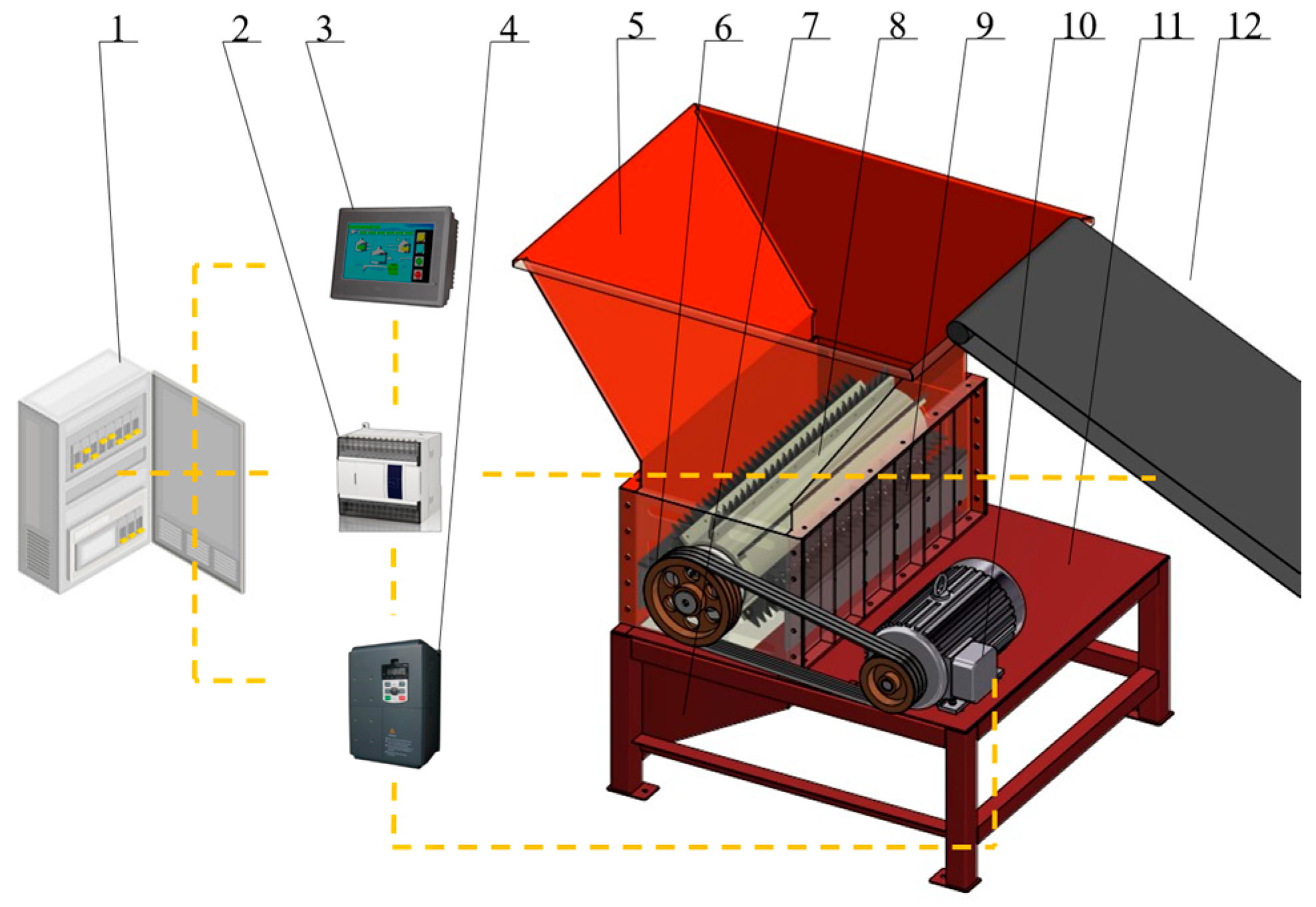


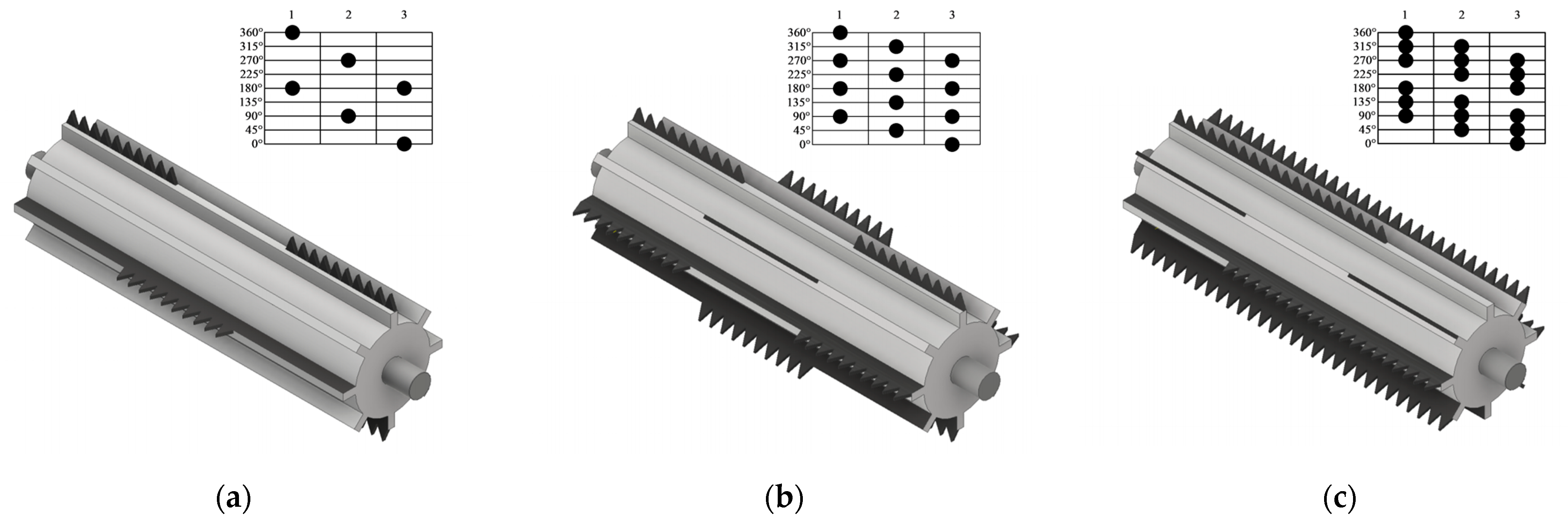

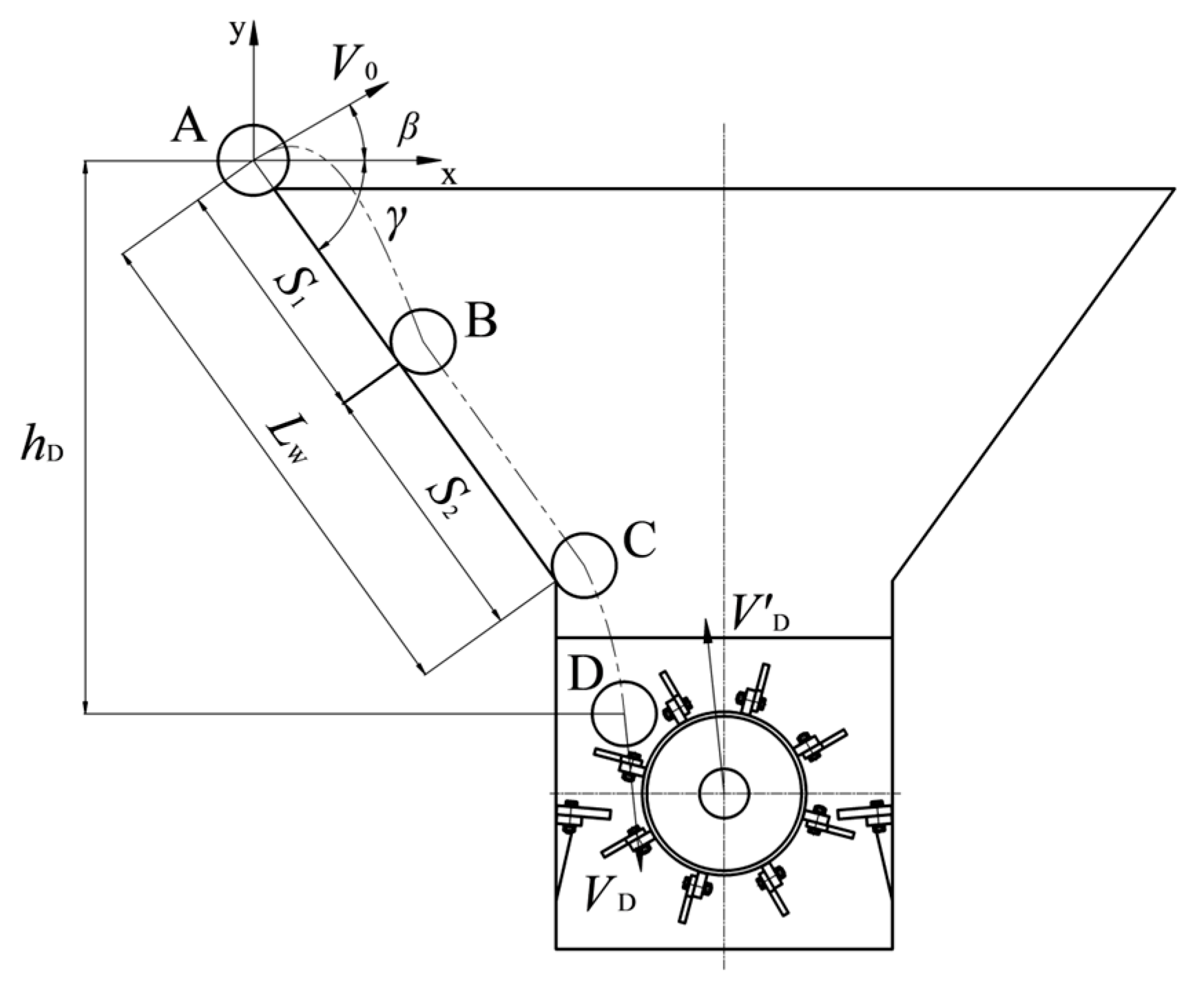

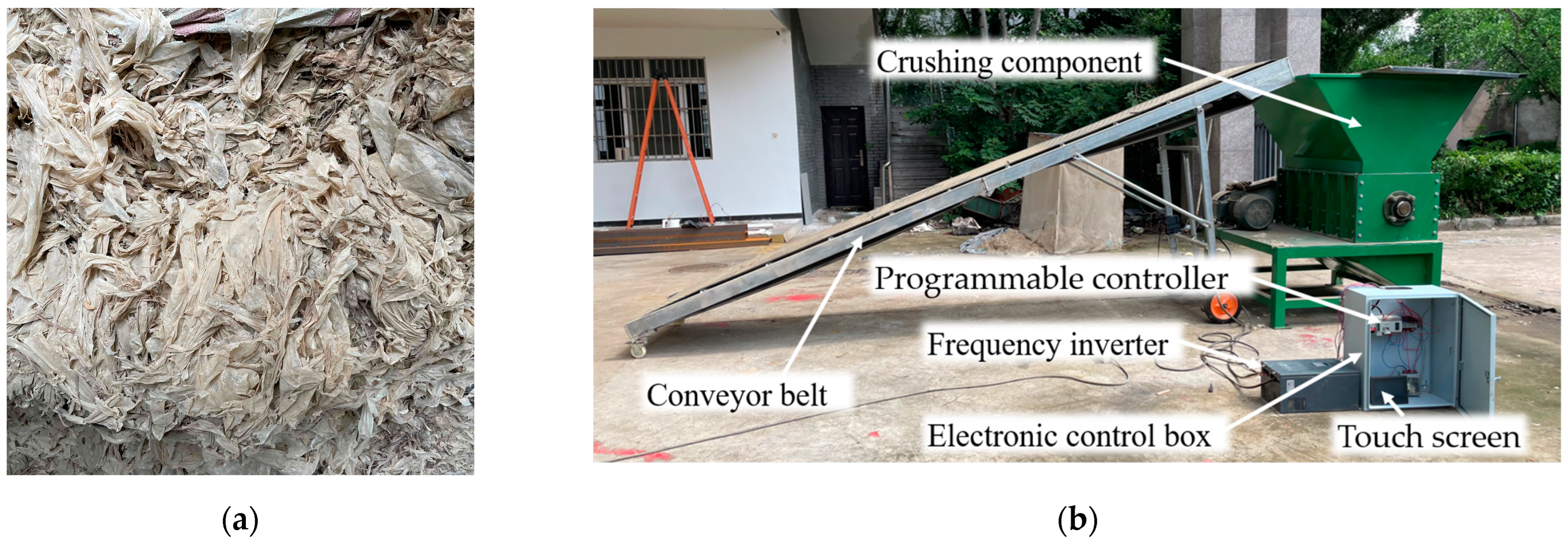
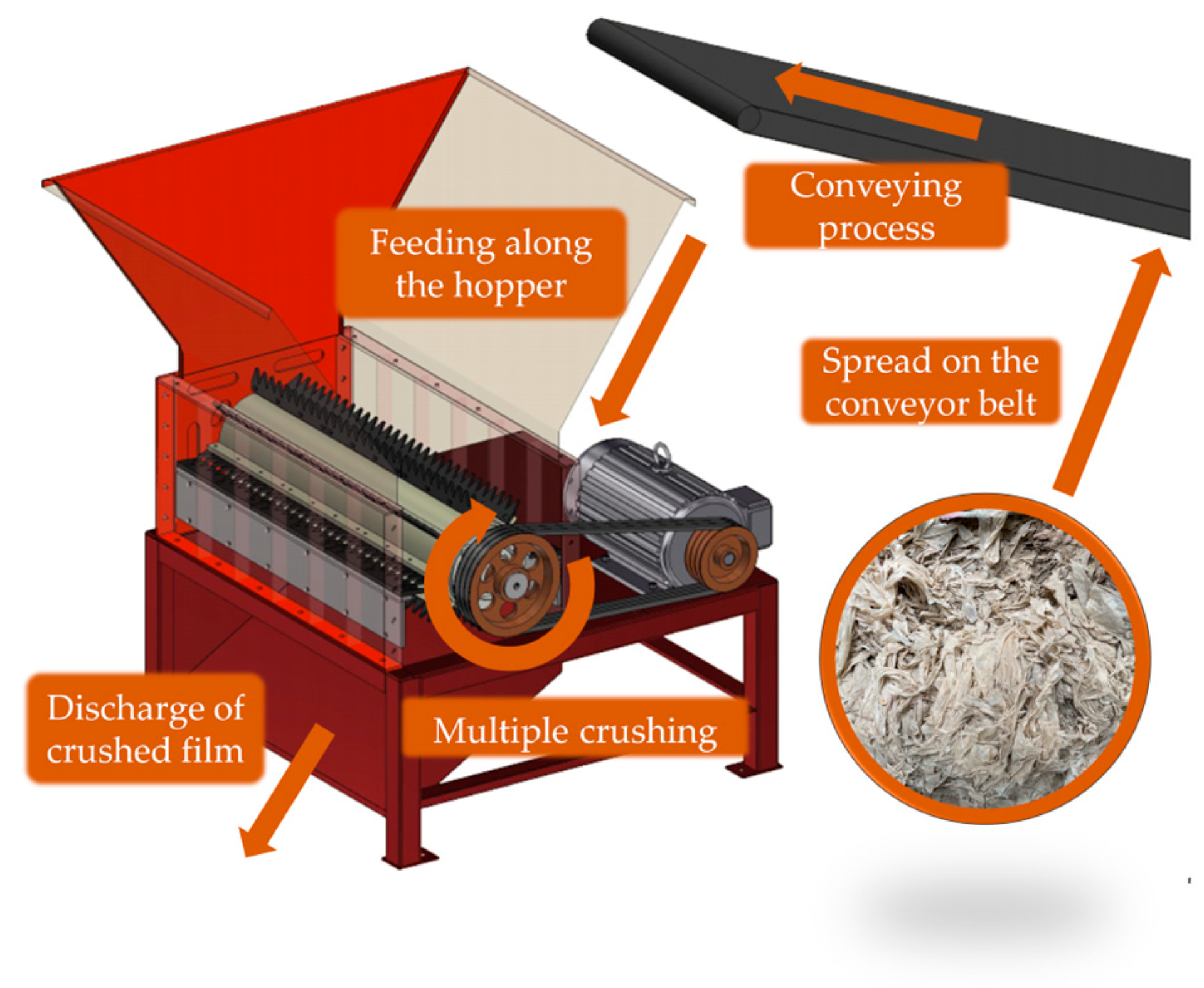


| Items | Crushing Rollers | Mode 1 | Mode 2 | Mode 3 | Mode 4 | Mode 5 | Mode 6 |
|---|---|---|---|---|---|---|---|
| Excitation frequency (Hz) | T1 | 401.71 | 402.27 | 467.84 | 1231.23 | 1234.82 | 1265.42 |
| T2 | 400.73 | 400.87 | 459.13 | 1226.91 | 1227.60 | 1260.52 | |
| T3 | 400.75 | 401.64 | 458.60 | 1225.78 | 1226.69 | 1264.03 | |
| Maximum deformation (mm) | T1 | 1.85 | 1.79 | 2.89 | 2.26 | 1.88 | 1.46 |
| T2 | 1.79 | 1.79 | 2.86 | 1.98 | 2.01 | 1.47 | |
| T3 | 1.85 | 1.79 | 2.85 | 2.39 | 2.25 | 4.12 |
| Levels | Feeding Speed X1 (m/s) | Number of Cutter Toothed Plates X2 | Crushing Roller Rotation Speed X3 (r/min) |
|---|---|---|---|
| −1 | 0.250 | 6 | 600 |
| 0 | 0.325 | 12 | 750 |
| 1 | 0.400 | 18 | 900 |
| No. | X1 (m/s) | X2 | X3 (r/min) | Y1 (%) | Y2 (%) |
|---|---|---|---|---|---|
| 1 | 0.250 | 18 | 750 | 81.64 | 15.04 |
| 2 | 0.325 | 12 | 750 | 86.65 | 8.94 |
| 3 | 0.325 | 18 | 600 | 78.35 | 19.51 |
| 4 | 0.325 | 6 | 600 | 76.70 | 19.23 |
| 5 | 0.250 | 12 | 600 | 79.18 | 10.72 |
| 6 | 0.400 | 6 | 750 | 80.05 | 14.94 |
| 7 | 0.325 | 12 | 750 | 86.77 | 9.25 |
| 8 | 0.325 | 12 | 750 | 87.94 | 8.87 |
| 9 | 0.325 | 18 | 900 | 84.26 | 19.05 |
| 10 | 0.400 | 12 | 600 | 86.35 | 14.95 |
| 11 | 0.400 | 12 | 900 | 85.92 | 9.15 |
| 12 | 0.325 | 12 | 750 | 89.01 | 8.53 |
| 13 | 0.250 | 12 | 900 | 88.01 | 9.56 |
| 14 | 0.325 | 6 | 900 | 75.57 | 14.98 |
| 15 | 0.250 | 6 | 750 | 74.11 | 14.76 |
| 16 | 0.400 | 18 | 750 | 80.47 | 18.33 |
| 17 | 0.325 | 12 | 750 | 86.93 | 9.76 |
| Source | Sum of Squares | df | Mean Square | F-Value | p-Value |
|---|---|---|---|---|---|
| Model | 370.06 | 9 | 41.12 | 44.90 | <0.0001 ** |
| X1 | 12.13 | 1 | 12.13 | 13.24 | 0.0083 ** |
| X2 | 41.82 | 1 | 41.82 | 45.66 | 0.0003 ** |
| X3 | 21.71 | 1 | 21.71 | 23.71 | 0.0018 ** |
| X1X2 | 12.64 | 1 | 12.64 | 13.80 | 0.0075 ** |
| X1X3 | 21.44 | 1 | 21.44 | 23.41 | 0.0019 ** |
| X2X3 | 12.39 | 1 | 12.39 | 13.53 | 0.0079 ** |
| X12 | 5.32 | 1 | 5.32 | 5.81 | 0.0468 * |
| X22 | 222.46 | 1 | 222.46 | 242.94 | <0.0001 ** |
| X32 | 9.11 | 1 | 9.11 | 9.95 | 0.0160 * |
| Residual | 6.41 | 7 | 0.9157 | ||
| Lack of fit | 2.36 | 3 | 0.7880 | 0.7791 | 0.5640 |
| Pure error | 4.05 | 4 | 1.01 | ||
| Cor total | 376.47 | 16 |
| Source | Sum of Squares | df | Mean Square | F-Value | p-Value |
|---|---|---|---|---|---|
| Model | 272.09 | 9 | 30.23 | 135.41 | <0.0001 ** |
| X1 | 6.64 | 1 | 6.64 | 29.75 | 0.0010 ** |
| X2 | 8.04 | 1 | 8.04 | 36.01 | 0.0005 ** |
| X3 | 17.02 | 1 | 17.02 | 76.25 | <0.0001 ** |
| X1X2 | 2.42 | 1 | 2.42 | 10.83 | 0.0133 * |
| X1X3 | 5.38 | 1 | 5.38 | 24.11 | 0.0017 ** |
| X2X3 | 3.59 | 1 | 3.59 | 16.08 | 0.0051 ** |
| X12 | 0.1684 | 1 | 0.1684 | 0.7543 | 0.4139 |
| X22 | 200.32 | 1 | 200.32 | 897.18 | <0.0001 ** |
| X32 | 20.84 | 1 | 20.84 | 93.36 | <0.0001 ** |
| Residual | 1.56 | 7 | 0.2233 | ||
| Lack of fit | 0.7059 | 3 | 0.2353 | 1.10 | 0.4468 |
| Pure error | 0.8570 | 4 | 0.2143 | ||
| Cor total | 273.66 | 16 |
| Items | X1 (m/s) | X2 | X3 (r/min) | Y1 (%) | Y2 (%) |
|---|---|---|---|---|---|
| Optimization solution | 0.30 | 12.34 | 815.44 | 87.95 | 8.83 |
| Verification solution | 0.300 | 12 | 815 | 82.55 | 9.57 |
Disclaimer/Publisher’s Note: The statements, opinions and data contained in all publications are solely those of the individual author(s) and contributor(s) and not of MDPI and/or the editor(s). MDPI and/or the editor(s) disclaim responsibility for any injury to people or property resulting from any ideas, methods, instructions or products referred to in the content. |
© 2023 by the authors. Licensee MDPI, Basel, Switzerland. This article is an open access article distributed under the terms and conditions of the Creative Commons Attribution (CC BY) license (https://creativecommons.org/licenses/by/4.0/).
Share and Cite
Guo, K.; Yang, H.; Cao, M.; Shen, H.; Chen, X.; Gu, F.; Wu, F.; Hu, Z. Design and Optimization of a Toothed-Plate Single-Roller Crushing Device for Waste Plastic Film. Appl. Sci. 2023, 13, 11650. https://doi.org/10.3390/app132111650
Guo K, Yang H, Cao M, Shen H, Chen X, Gu F, Wu F, Hu Z. Design and Optimization of a Toothed-Plate Single-Roller Crushing Device for Waste Plastic Film. Applied Sciences. 2023; 13(21):11650. https://doi.org/10.3390/app132111650
Chicago/Turabian StyleGuo, Kai, Hongguang Yang, Mingzhu Cao, Haiyang Shen, Xulei Chen, Fengwei Gu, Feng Wu, and Zhichao Hu. 2023. "Design and Optimization of a Toothed-Plate Single-Roller Crushing Device for Waste Plastic Film" Applied Sciences 13, no. 21: 11650. https://doi.org/10.3390/app132111650







